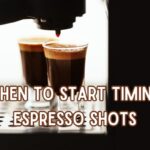When to start timing espresso shots. In the world of espresso making, timing is everything. When to start timing espresso shots is a crucial factor that determines the flavor, consistency, and overall quality of your espresso. This comprehensive guide will delve into the art of timing espresso shots to help you achieve the perfect blend every time.
By understanding the factors that affect timing and adopting best practices, you can achieve consistency and precision in your espresso-making skills. This article will provide all the essential information to time your espresso shots correctly and create an exceptional coffee experience.
Throughout this guide, we will cover various aspects of timing espresso shots, including timing, factors to consider, tips for consistent timing, experimenting with timing for different flavor profiles, and troubleshooting timing issues.
Whether you’re an experienced barista or a home brewer, mastering the art of timing espresso shots is essential for creating the perfect cup of coffee every time. Let’s start by exploring when to start timing espresso shots and how they contribute to your espresso’s overall flavor and quality.
Why timing espresso shots is crucial for a remarkable coffee experience?
If you want to create the perfect espresso shot, timing is everything. By mastering the art of timing, you can achieve an exceptional, balanced, and flavorful result. In this section, we’ll explore the tips and techniques for getting the perfect timing so you can pull shots consistently, just like a professional barista.
Espresso shot timing tips
When it comes to timing espresso shots, there are a few essential tips to keep in mind:
- Consistency is key: To ensure a consistently good shot, it’s important to time each shot consistently.
- Preparation is key: Ensure your equipment is clean and calibrated beforehand for the best results.
- Pay attention to the details: Things like the temperature and humidity of your environment can impact the timing, so be mindful of your surroundings.
With these tips in mind, you’ll be well on your way to achieving the perfect timing for your espresso shots.
Perfect timing for pulling espresso shots
So, what is the perfect timing for pulling espresso shots? The answer is complex, as it depends on several factors. A traditional espresso shot is typically pulled in about 25-30 seconds. However, this timing can vary depending on the beans roast, the machine used, and the desired flavor profile.
For example, darker roasts may require a longer extraction time as they are denser and less soluble than lighter roasts. Similarly, if you’re going for a sweeter flavor, a shorter extraction time of around 20-25 seconds could be the way to go. Experimenting with different timing techniques will enable you to achieve the perfect shot that suits your preference.
Ultimately, timing is just one factor in the espresso-making process, but it’s an essential one that should be considered. With the right timing techniques and practice, you can create consistently exceptional shots that rival those of the best baristas in the industry.
Factors to Consider When Timing Espresso Shots

Timing your espresso shots involves considering various factors affecting the extraction process. Knowing when to start the shot timer for espresso and timing espresso extraction is crucial for achieving the perfect blend every time. Here are some essential factors to consider:
Grind Fineness
The fineness of your coffee grind can impact the extraction time. A finer grind may require less time, while a coarser grind may need more time to extract the flavors properly. Generally, fine grinding is suitable for machines with high-pressure extraction systems, while coarser grinding is best for machines with low-pressure extraction systems.
Coffee Dose
The amount of coffee used, or the coffee dose, can also affect the extraction time. Using too little coffee can result in a weak and watery shot while using too much coffee can result in an over-extracted and bitter shot. As a guideline, use a dose of 18-21 grams of ground coffee for a double shot and adjust according to your preference.
Water Temperature
The water temperature can significantly impact the extraction process, affecting how quickly the flavors are dissolved from the coffee grounds. The ideal water temperature is between 195°F and 205°F (90°C-96°C). However, if the water is too hot, it can burn the coffee and result in a bitter taste, while too cold water can result in an under-extracted and weak shot.
Water Pressure
The water pressure affects the speed at which the water passes through the coffee grounds, impacting the extraction time and the flavor profile. High-pressure extraction systems require less time, around 20-30 seconds, while low-pressure extraction systems may need up to a minute for optimal extraction.
Shot Volume
The shot volume, or how much espresso is extracted, can affect the extraction time and the flavor profile. A standard double shot is around 2 ounces, but some prefer a longer extraction time for a larger volume. Be mindful of the volume and adjust the timing accordingly.
Understanding the Importance of Pre-Infusion
Pre-infusion is a crucial step in the espresso-making process that involves wetting the coffee grounds before the full extraction. Pre-infusion sets the foundation for a balanced and flavorful shot by allowing the coffee to bloom and expand.
The timing of pre-infusion is key to achieving the desired results. Pre-infusion typically lasts 5-10 seconds but can be adjusted based on the coffee blend, roast level, and machine. If the pre-infusion is longer, the coffee may be under-extracted, resulting in a sour and acidic taste. On the other hand, a prolonged pre-infusion can lead to over-extraction and a bitter taste.
Timing the pre-infusion requires a bit of trial and error and depends on various factors, including the grinder, machine, coffee blend, and even the water temperature. However, the general rule is to start the shot timer when the pre-infusion begins.
Tip: Experiment with pre-infusion timings to find the right balance of flavor and strength for your espresso shots. Keep a record of your findings for future reference.
The role of brew ratio in timing espresso shots

One of the essential factors to consider when timing your espresso shots is the brew ratio, which refers to the ratio of coffee grounds to water. The brew ratio affects the strength and the balance of flavors in your espresso.
The standard brew ratio for espresso is 1:2, which means using 18 grams of ground coffee to extract 36 grams of liquid. However, this ratio can be adjusted to suit your taste preferences and the beans you use. For example, if you prefer a stronger espresso, you can increase the amount of coffee used.
When adjusting the brew ratio, it’s important to remember that it will affect the timing of your espresso extraction. A higher coffee-to-water ratio will result in a slower extraction time, while a lower ratio will lead to a faster extraction time. Therefore, you must adjust the timing accordingly to avoid over or under-extraction.
Timing espresso shots with a higher brew ratio:
If you increase the amount of coffee used in your espresso, you must adjust the timing accordingly to avoid over-extraction. Pulling the shot for too long can result in a bitter taste while pulling it too quickly can lead to an under-extracted shot with a weak flavor.
The optimal timing for a higher brew ratio is around 30 seconds. However, you should adjust this time based on the specific characteristics of your coffee beans and the taste you are aiming for. Remember that a higher brew ratio will generally result in a slower extraction time, so you may need to extend the timing to ensure a balanced and flavorful shot.
Timing espresso shots with a lower brew ratio:
If you use a lower brew ratio for your espresso, the extraction time will be faster than usual. In this case, you must adjust the timing to ensure optimal extraction and flavor.
The optimal timing for a lower brew ratio is around 20-25 seconds. However, similar to adjusting for a higher brew ratio, you should also consider the characteristics of your coffee beans and your taste preferences. Pulling the shot for too long could result in a bitter taste while pulling it too quickly could lead to an under-extracted shot with a weak flavor.
By monitoring and adjusting the timing of your espresso shots based on the brew ratio, you can balance flavors and create the perfect espresso.
Techniques for Consistent Espresso Shot Timing
Mastering timing techniques is crucial to achieving consistent and high-quality espresso shots. Here are some tips to ensure accurate and precise timing every time you pull a shot:
Use a Shot Timer
Invest in a reliable shot timer to keep track of the extraction time. This tool eliminates the guesswork and ensures that every shot is consistent. Start the timer when you hit the brew button and stop it when the desired amount of espresso is extracted.
Observe Visual Cues
Visual cues are also helpful in timing your espresso shots. Watch for the color and texture of the espresso as it is extracted. The ideal extraction time is typically when the espresso has a consistent, honey-like flow with a thick and silky crema on top.
Adjust the Grind Size
The grind size affects the extraction rate, so adjusting it can impact the timing of your espresso shots. Finer grinds tend to extract faster, while coarser grinds take longer. Experiment with different grind sizes until you find the perfect balance.
Standardize Your Tamping Pressure
The pressure when tamping the coffee grounds can also affect the extraction time. Standardize the pressure of your tamp to ensure consistent results. Too much pressure can slow extraction, while too little pressure can result in an uneven extraction.
Practice, Practice, Practice
Like any skill, timing espresso shots takes practice. Adjust your technique, timing, and equipment as needed, and keep practicing until you find the perfect combination. Keep notes on what works and what doesn’t, and refine your process until you achieve consistent and high-quality espresso shots every time.
Experimenting with timing for flavor profiles

As you become more experienced with timing espresso shots, you will recognize how adjusting the timing can result in different taste profiles. Experimenting with timing is great for achieving specific flavors and elevating your espresso-making skills. Here are some tips for finding the best timing for your espresso shots:
- Adjust the shot volume: The shot volume, or the amount of espresso extracted, can impact the flavor profile. Try adjusting the volume to see how it affects the taste.
- Change the grind size: Experimenting with different grind sizes can help you achieve a different flavor profile. Finer grinds typically produce a more intense and acidic taste, while coarser grinds produce a milder and sweeter flavor.
- Experiment with pre-infusion time: Varying the time for pre-infusion can alter the flavor profile. Longer pre-infusion times can lead to a sweeter and more balanced taste.
Remember that different beans and roasts may require different timing to achieve the desired flavor profile. The best way to find the perfect timing for your espresso shots is through experimentation and practice.
Troubleshooting timing issues
Timing espresso shots can sometimes present challenges, even to the most experienced baristas. Many variables can impact the extraction time, from the grind’s coarseness to the coffee beans’ quality. Here are some of the most common timing issues and tips to overcome them:
Issue 1: Shots are pulling too quickly
If your shots are pulling too quickly, it may be because the grind is too coarse or the dosage is too low. Try adjusting the grind to be finer or increasing the amount of coffee used.
Issue 2: Shots are pulling too slowly
If your shots are pulling too slowly, it may be because the grind is too fine or the dosage is too high. Try adjusting the grind to be coarser or decreasing coffee use.
Issue 3: Inconsistent timing
Various factors, including uneven tamping pressure or an inconsistent water supply, can cause inconsistent timing. Ensure that you apply even pressure when tamping and that your machine has a consistent water supply.
Pro Tip: Keep a log of your shots' extraction times, including any adjustments you make to the grind or dosage. This can help you identify patterns and troubleshoot timing issues more effectively.
Mastering the Art of Timing Espresso Shots
Timing espresso shots is an essential skill for any barista who wants to achieve consistently high-quality coffee. By understanding the principles and techniques of timing espresso shots, you can master the art of espresso making.
One of the key factors to keep in mind is the brew time. The ideal brew time for espresso is between 20-30 seconds, depending on the roast level and the desired flavor profile. By paying close attention to the timing, you can adjust the grind size, water temperature, and other variables to achieve the perfect balance.
Tips to Mastering Espresso Shot Timing:
- Use a shot timer to track the brew time precisely.
- Adjust the grind size to achieve the desired extraction time.
- Ensure your espresso machine is heating to the correct temperature to avoid over or under-extraction.
- Practice consistency in tamping pressure and distribution to minimize variables.
- Observe the visual cues, such as the crema color and thickness, to gauge the extraction quality.
- Experiment with different timings to achieve specific flavor profiles.
Incorporating these tips into your espresso-making routine will help you achieve consistent, high-quality shots. Remember that mastering timing is not an overnight process and requires patience and practice. With time and experience, you will become a skilled barista capable of always pulling exceptional espresso shots.


